As an Amazon Associate KitchenwareSets.com earns from qualifying purchases.
9 Genius Small Kitchen Remodel Hacks for More Space
Is your small kitchen a source of daily frustration? Do you find yourself playing a constant game of Tetris with pots and pans, with barely an inch of free counter space to chop an onion? It’s a common struggle where the heart of the home feels more like a cramped, inefficient closet.
This feeling of being overwhelmed is completely valid. You’re dealing with cluttered countertops, disorganized storage, and a layout that just doesn’t work for your life. It can make cooking feel like a chore rather than a joy, leaving you wondering if a functional, beautiful kitchen is even possible in your limited footprint.
The solution lies in a small kitchen remodel that focuses on maximizing every inch through smart storage, multi-functional elements, and clever visual tricks. The key is to strategically use vertical space, choose compact and efficient appliances, and implement proven design tipss that create a kitchen that not only feels significantly larger but also works harder for you every single day.
Feeling Overwhelmed by Your Small Kitchen? Here’s How to Reclaim Your Space
Living with a cramped kitchen can feel like a constant battle. The lack of counter space for meal prep, the struggle to find a spot for the new air fryer, and the general feeling of being boxed in are all too real. It’s a daily friction point that can zap the joy out of cooking and hosting. You might look at your outdated, limited space and think a major, wall-breaking renovation is the only answer.
But what if you could achieve a dramatic transformation without adding a single square foot? What if the kitchen you have right now holds untapped potential for incredible functionality and style? It’s entirely possible. We’ve helped countless homeowners tackle this exact challenge, transforming cluttered, tiny kitchens into highly efficient and beautiful spaces. We know what works.
This isn’t about wishing for a bigger home; it’s about making your current home work smarter for you. By rethinking storage, light, and layout, you can solve your biggest frustrations and create a kitchen that feels open, organized, and inspiring. We’re about to show you nine genius, actionable tipss that will help you reclaim your kitchen and fall in love with your space all over again.
9 Genius Small Kitchen Remodel Hacks for More Space (2025 Update)
The top tipss for a small kitchen remodel include: 1. Go Vertical with Wall Storage, 2. Install Clever Toe-Kick Drawers, 3. Add a Mobile Kitchen Island, 4. Use Over-the-Sink Workstations, 5. Brighten with Under-Cabinet Lighting, 6. Create Illusions with Reflective Surfaces, 7. Build a Hidden Rolling Pantry, 8. Swap Cabinets for Open Shelving, and 9. Install a Fold-Down Table. These transformative ideas are curated from top interior designers and successful real-world “before and after” projects, ensuring they are both stylish and practical.
Each of these strategies is designed to tackle the biggest challenges of a compact kitchen: insufficient storage, limited counter space, and visual clutter. Whether you’re planning a full renovation or looking for high-impact weekend projects, these tipss are chosen for their ability to deliver amazing results across various budget levels. Get ready to unlock the hidden potential in your kitchen.
1. Go Vertical: The Wall Is Your New Best Friend
The most effective way to gain storage is to utilize your vertical wall space with open shelving, pegboards, or wall-mounted racks. This simple shift draws the eye upward, making the room feel taller while moving bulky items like pots, pans, and everyday dishes off your valuable countertops. Instead of seeing walls as boundaries, view them as prime real estate for storage and display.
Open shelving, in particular, can make a small kitchen feel significantly lighter and more open than traditional upper cabinets. It allows you to showcase beautiful dinnerware or organized jars, turning functional storage into a decorative feature. Similarly, a customizable pegboard offers incredible flexibility for hanging utensils, mugs, and even small herb planters.
- Materials Needed: Wall stud finder, level, drill, wall anchors, high-quality shelves or pegboard system, screws.
- Step-by-Step Directions:
- Identify the items you want to display or store on the wall (e.g., daily dishes, pots, spices).
- Use a stud finder to locate secure mounting points on your wall. Mark them lightly with a pencil.
- Use a level to ensure your brackets or pegboard will be straight. Mark the drill holes.
- Drill pilot holes and install wall anchors if you are not drilling into a stud.
- Securely mount your shelving brackets or pegboard to the wall.
- Arrange your items, placing heavier items on the bottom shelves or closer to the brackets.
Pro-Tip: When using open shelving, stick to a cohesive color palette for your dishes and cookware to prevent the wall from looking cluttered. This creates a curated, high-design look.
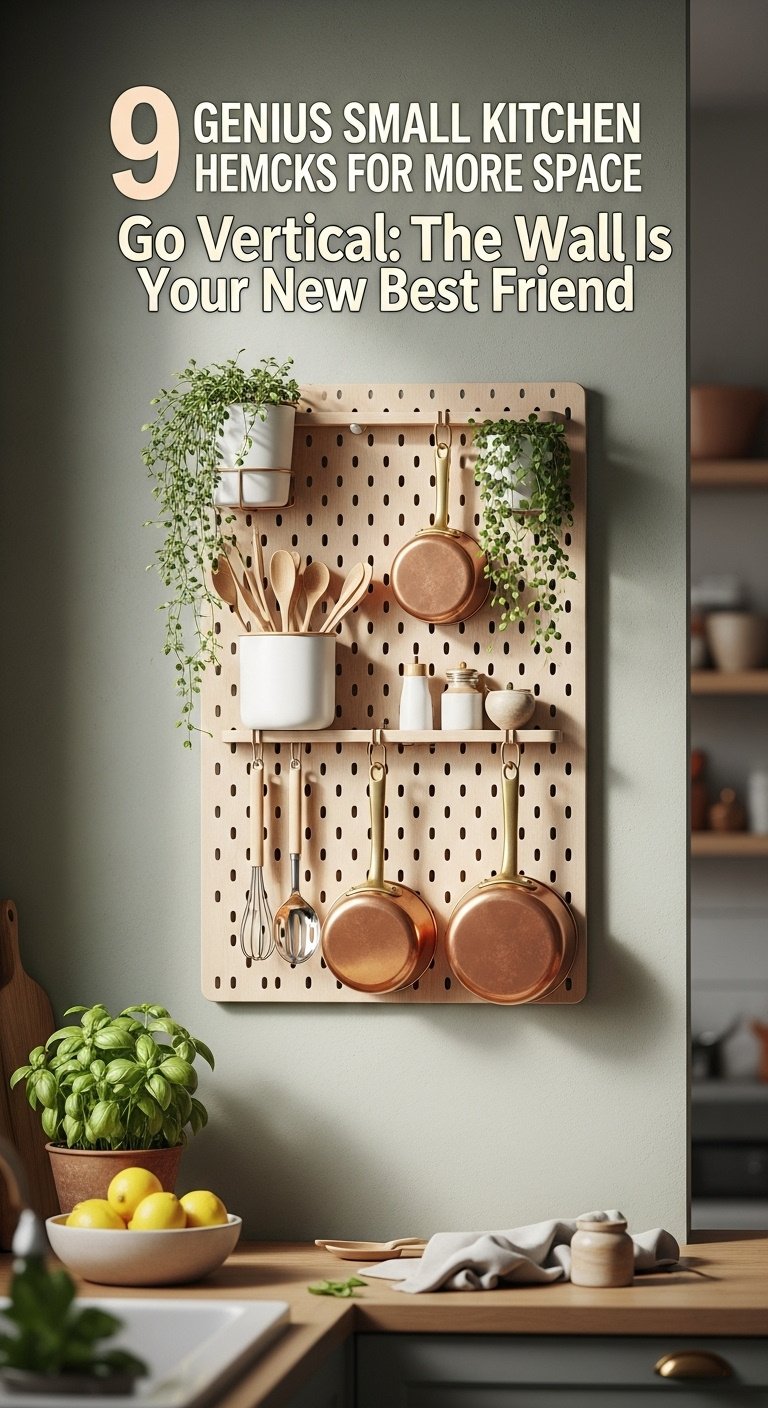
Pin this vertical storage solution to your “Dream Kitchen” board!
2. Unlock Hidden Space with Toe-Kick Drawers
You can create surprising new storage by installing shallow drawers in the often-wasted space beneath your base cabinets. This area, known as the toe-kick, is typically just a decorative board, but it can be transformed into the perfect hiding spot for flat items like baking sheets, cutting boards, serving platters, and kitchen linens.
This tips is the epitome of smart, space-saving design. It utilizes a footprint that already exists but is almost universally ignored. By converting this dead space, you free up deeper, more valuable drawers and cabinets for bulkier items. It’s a custom touch that makes a kitchen feel incredibly well-thought-out and efficient.
- Materials Needed: Plywood for drawer box, drawer slides (low-profile), drawer front matching your cabinets, push-to-open hardware, measuring tape, saw, drill.
- Step-by-Step Directions:
- Carefully remove the toe-kick board from a section of your base cabinets.
- Measure the height, width, and depth of the opening.
- Construct a simple, shallow drawer box from plywood that is slightly smaller than your measurements.
- Install the low-profile drawer slides onto the bottom of the cabinet interior and the sides of your drawer box.
- Attach the push-to-open hardware to the back of the cabinet cavity and the drawer.
- Attach the drawer front (your original toe-kick board or a matching new piece) to the front of the drawer box.
Lesson Learned: Always use push-to-open hardware for toe-kick drawers. Since there’s no room for a handle, this mechanism makes them easy to open with a simple tap of your foot.
![]()
Love hidden storage? Share this genius tips with a friend!
3. Add a Flexible Mobile Island or Cart
A portable kitchen island or a sturdy cart on wheels provides a dynamic solution for adding counter space and storage exactly when and where you need it. Unlike a permanent island that can crowd a small kitchen, a mobile unit offers incredible flexibility. You can use it as a prep station, a coffee bar, a serving cart for guests, or simply roll it out of the way to open up the floor plan.
Look for carts with features that suit your needs, such as a butcher block top for chopping, shelves for storing appliances, or hooks for hanging towels and utensils. This single piece of furniture can solve multiple small-kitchen problems at once, making it one of the most versatile and impactful additions you can make.
- Materials Needed: A pre-made kitchen cart/island OR a small bookshelf/cabinet, locking caster wheels, drill, butcher block top (optional), wood screws.
- Step-by-Step Directions:
- Choose a cart or a small cabinet that fits the scale of your kitchen. Ensure it has useful shelving or drawers.
- If converting a cabinet, flip it upside down.
- Securely attach one locking caster wheel to each of the four corners using a drill and wood screws.
- (Optional) If you want a more durable work surface, cut a piece of butcher block to the size of the top and secure it from underneath with screws.
- Flip it upright and roll it into place. Always lock the wheels when using it as a prep surface.
Pro-Tip: Look for a mobile cart that is “counter height” (typically 36 inches) so it can serve as a seamless extension of your existing countertops for a comfortable food prep experience.
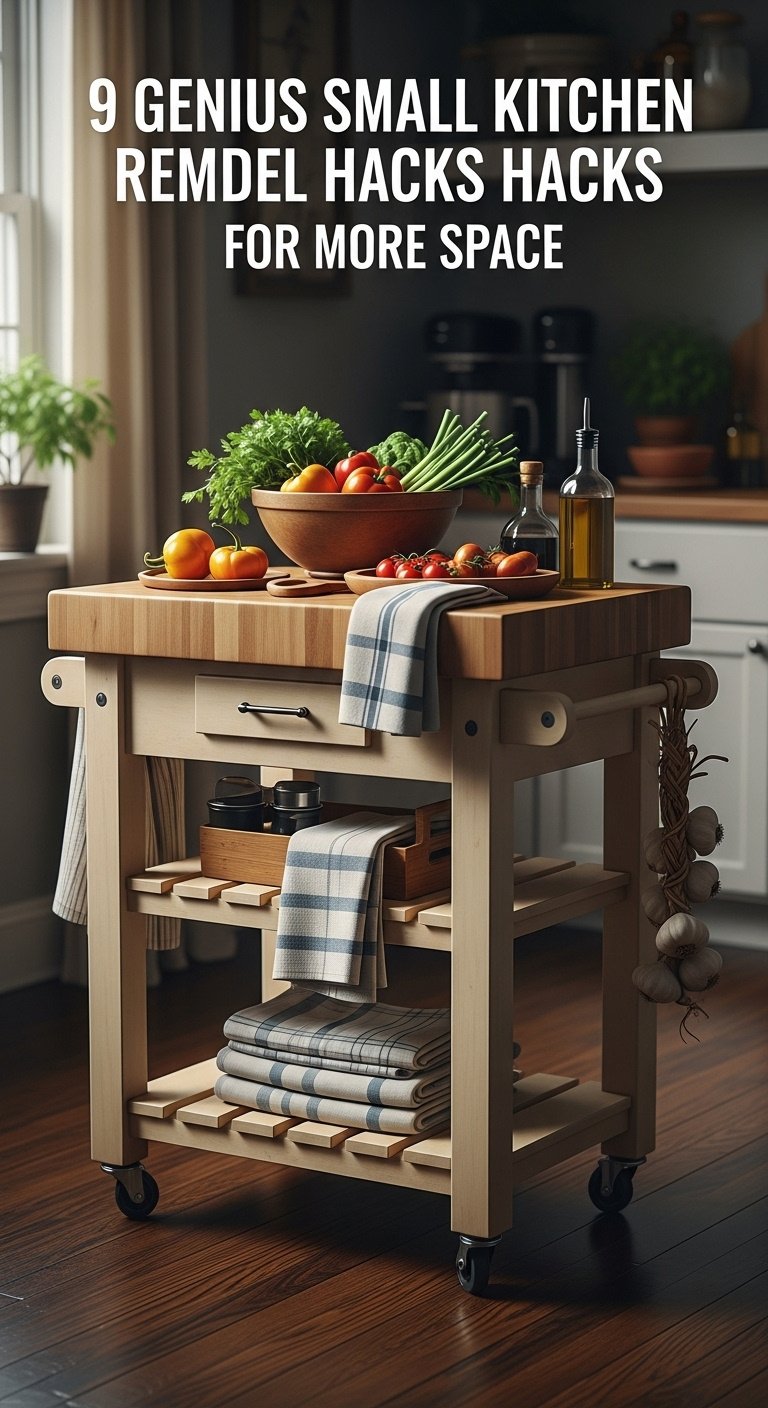
Need more counter space? Pin this flexible solution!
4. Maximize Your Sink with Over-the-Sink Accessories
You can instantly create more usable workspace by transforming your sink into a multi-functional prep area with accessories like a roll-up drying rack or an integrated cutting board. These clever tools allow you to perform tasks directly over the sink, effectively giving you back the counter space that a traditional dish rack or a chopping board would normally occupy.
An over-the-sink cutting board is perfect for chopping vegetables, allowing you to sweep scraps directly into the disposal. A roll-up drying rack is even more versatile; it can be used for drying dishes, rinsing produce, or even as a trivet for hot pans. When you’re done, it simply rolls up for compact storage, leaving your counter completely clear.
- Materials Needed: An over-the-sink cutting board, a roll-up dish drying rack, or an expandable colander designed for sinks.
- Step-by-Step Directions:
- Precisely measure the inside opening of your kitchen sink, from front to back and side to side.
- Purchase accessories that are designed to fit your sink’s dimensions. Look for adjustable or expandable options for a perfect fit.
- Place the cutting board over one half of the sink to chop vegetables, allowing scraps to be easily swept into the disposal.
- Unroll the drying rack over the sink to dry dishes without taking up any counter space. When done, simply roll it up and store it away.
Pro-Tip: Investing in a high-quality roll-up drying rack made from silicone-coated stainless steel is worth it. It’s sturdy enough to hold heavy pots, heat-resistant to act as a trivet, and won’t rust.
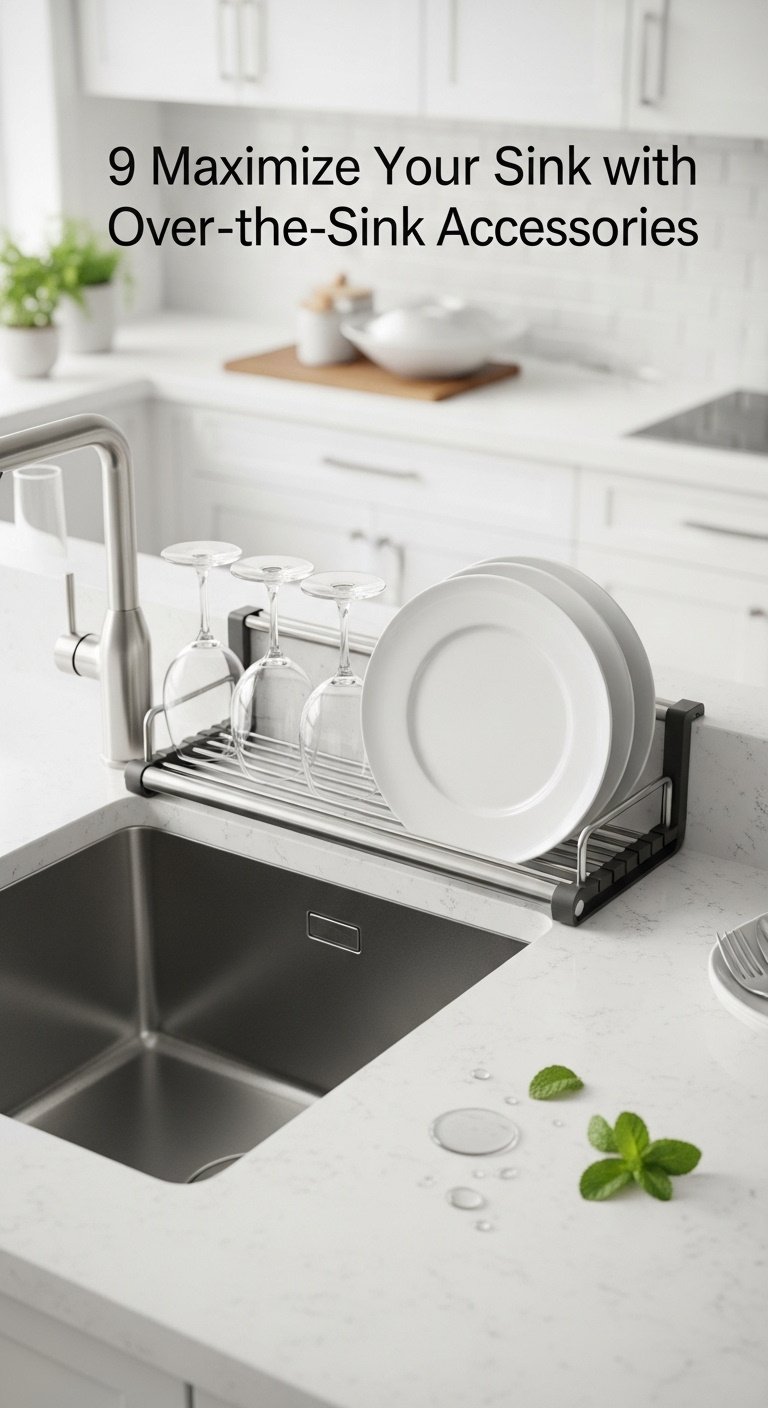
Save this space-saving sink tips to your “Kitchen Remodel” board!
5. Brighten Up with Smart Under-Cabinet Lighting
A simple and effective way to make your kitchen feel larger is by installing under-cabinet lighting to illuminate your countertops and eliminate dark shadows. This addition has a dual benefit: it provides essential task lighting for cooking and prep, making your workspace safer and more efficient, and it creates an ambient glow that adds depth and openness to the entire room.
Dark corners make a space feel smaller and more enclosed. By washing your countertops and backsplash with light, you visually push the walls back. Modern LED strips are incredibly easy to install—many are peel-and-stick—making this a budget-friendly DIY project you can complete in an afternoon for a truly transformative effect.
- Materials Needed: LED light strip kit (with power adapter), measuring tape, scissors, cleaning alcohol, paper towels.
- Step-by-Step Directions:
- Thoroughly clean the underside of your upper cabinets with rubbing alcohol to ensure the adhesive will stick. Let it dry completely.
- Measure the length of your cabinets and cut the LED strip at the designated cut marks.
- Peel back the adhesive backing and press the light strip firmly onto the underside of the cabinets. It’s best to place it towards the front for optimal task lighting on the counter.
- Connect the light strip to the power adapter and run the cord discreetly down the wall or behind the backsplash to the nearest outlet.
Pro-Tip: Choose a “warm white” (around 2700K-3000K) light temperature for a cozy, inviting feel. “Cool white” can sometimes feel too harsh or clinical in a kitchen environment.
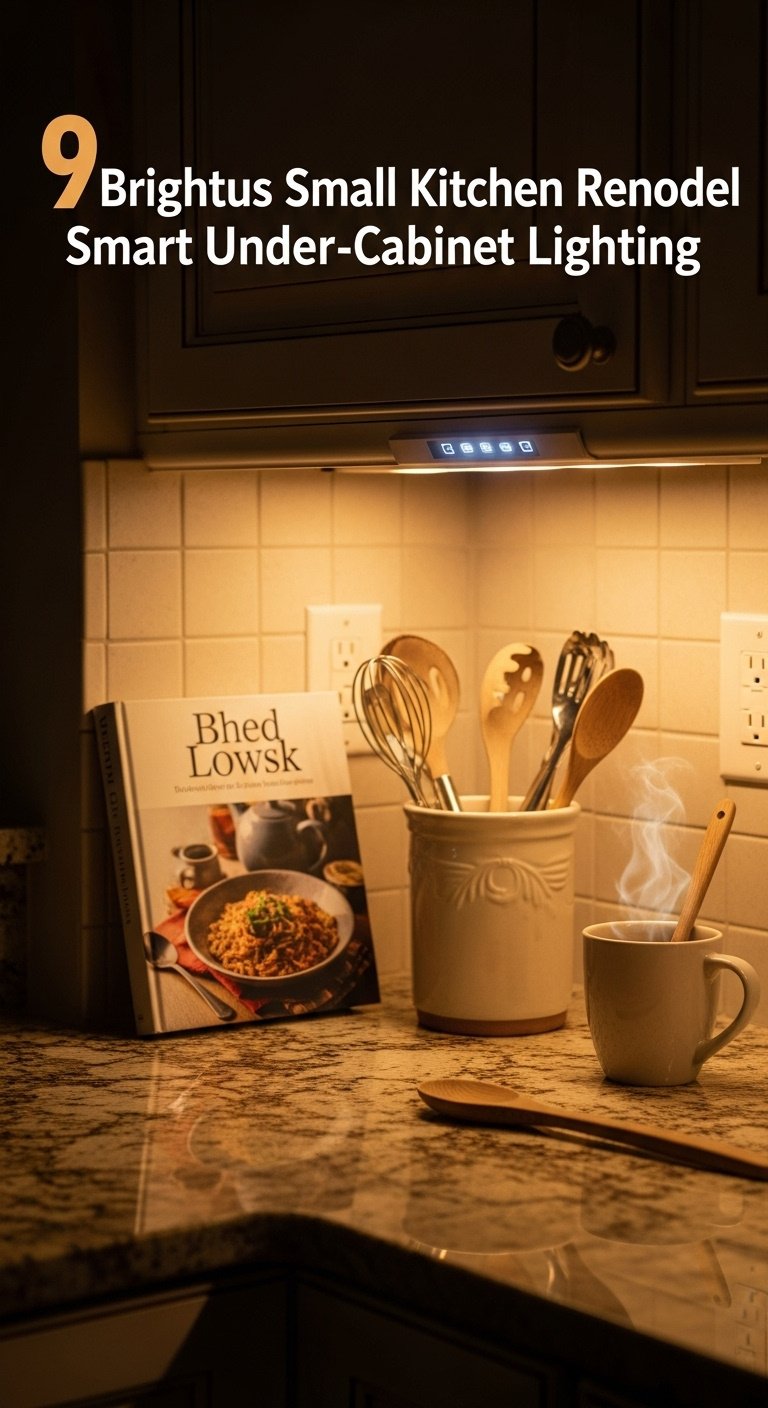
Instantly upgrade your kitchen with this lighting trick. Pin it for later!
6. Create the Illusion of Space with Reflective Surfaces
You can visually double your space by incorporating reflective materials like a mirrored backsplash, glossy cabinet finishes, or polished metal fixtures. These surfaces work by bouncing natural and artificial light around the room, which tricks the eye into perceiving more depth and openness. It’s a classic designer trick that works wonders in compact areas.
While a fully mirrored wall might be bold, you can achieve a similar effect with more subtle choices. Consider a backsplash made of mirrored subway tiles, glazed ceramic tiles with a high-sheen finish, or even just painting your cabinets with a semi-gloss or high-gloss paint. The goal is to create planes that catch and reflect light, breaking up solid surfaces and making the entire kitchen feel brighter and more expansive.
- Materials Needed: Your choice of reflective material: mirrored or glossy subway tiles, stainless steel sheeting, high-gloss cabinet paint, or a large unframed mirror.
- Step-by-Step Directions:
- For a Backsplash: Install mirrored tiles or a sheet of polished metal behind your stove or sink. This will bounce light around the room and reflect the space, making it feel deeper.
- For Cabinets: When repainting, choose a high-quality paint with a semi-gloss or high-gloss finish instead of matte. The sheen will reflect light.
- For an Accent Wall: Mount a large, simple mirror on a wall opposite a window to double the amount of natural light and create a significant illusion of depth.
Lesson Learned: While a full mirrored backsplash is dramatic, it can be high-maintenance. For a similar effect with easier cleaning, consider using glazed ceramic tiles which have a beautiful, light-reflecting sheen.
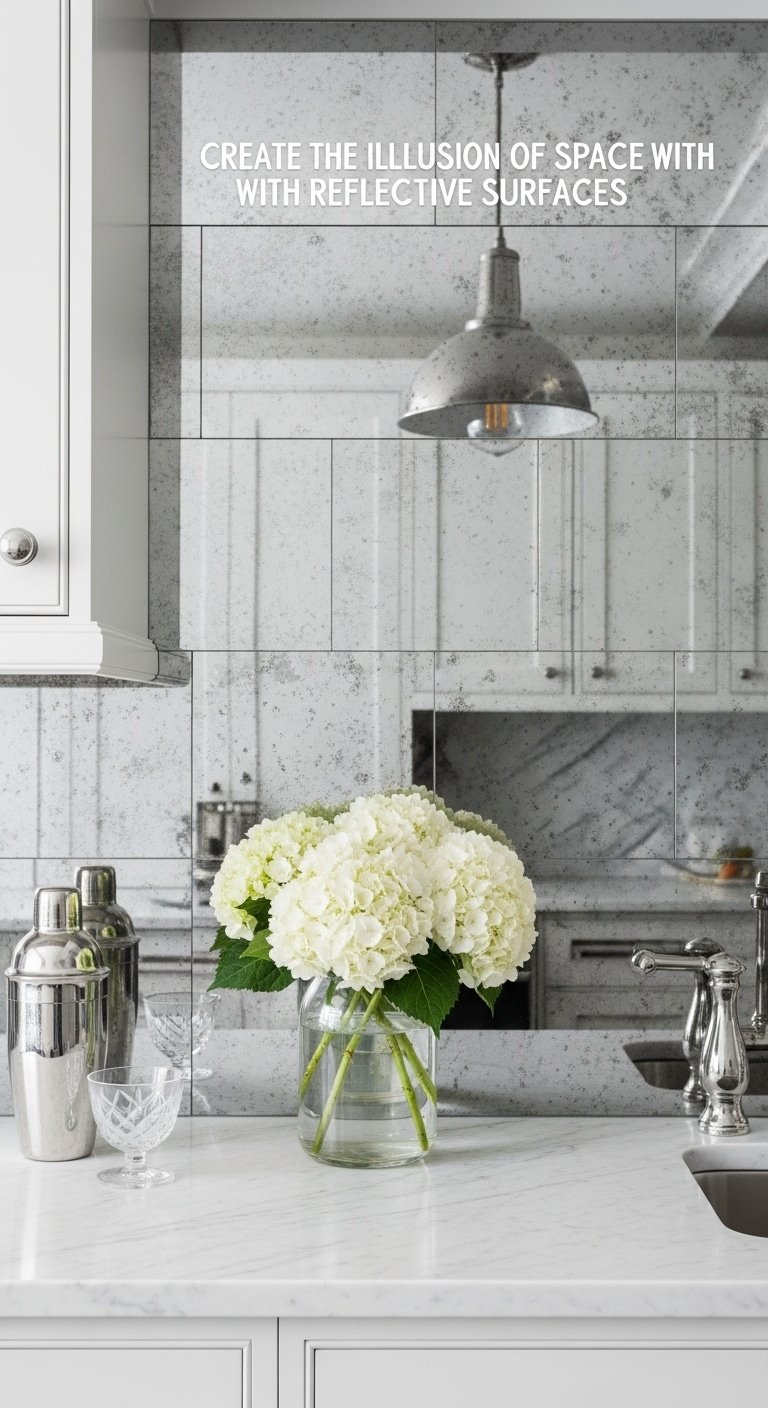
Make your kitchen feel huge! Save this visual trick to your design board.
7. Build a DIY Skinny Rolling Pantry
That awkward, narrow gap between your refrigerator and the wall can be transformed into a highly functional storage powerhouse with a custom-built, skinny rolling pantry. This DIY project captures otherwise wasted space and turns it into the perfect spot for canned goods, spices, oils, and other pantry staples. It keeps items organized and accessible while maintaining a clean, seamless look when tucked away.
This is a brilliant solution for adding a significant amount of storage without taking up any new floor space. With just a few basic materials from the hardware store, you can create a custom cart that fits your specific gap perfectly. It’s a satisfying project that solves a common storage dilemma in almost every small kitchen.
- Materials Needed: 1×4 lumber, thin plywood or beadboard for the back, wood glue, nails or screws, fixed caster wheels, a handle or pull.
- Step-by-Step Directions:
- Measure the height, depth, and width of the gap next to your fridge. Subtract half an inch from the width for clearance.
- Build a tall, narrow box frame using the 1×4 lumber to your measured dimensions, creating several shelves.
- Attach the thin plywood to the back of the frame to keep items from falling out.
- Securely attach at least four fixed caster wheels to the bottom.
- Install a handle on the front-facing side for easy pulling.
- Paint or stain to match your kitchen, then slide it into the gap.
Pro-Tip: Add small wooden dowels or a thin rail across the front of each shelf to prevent cans and jars from tipping over when you roll the pantry in and out.
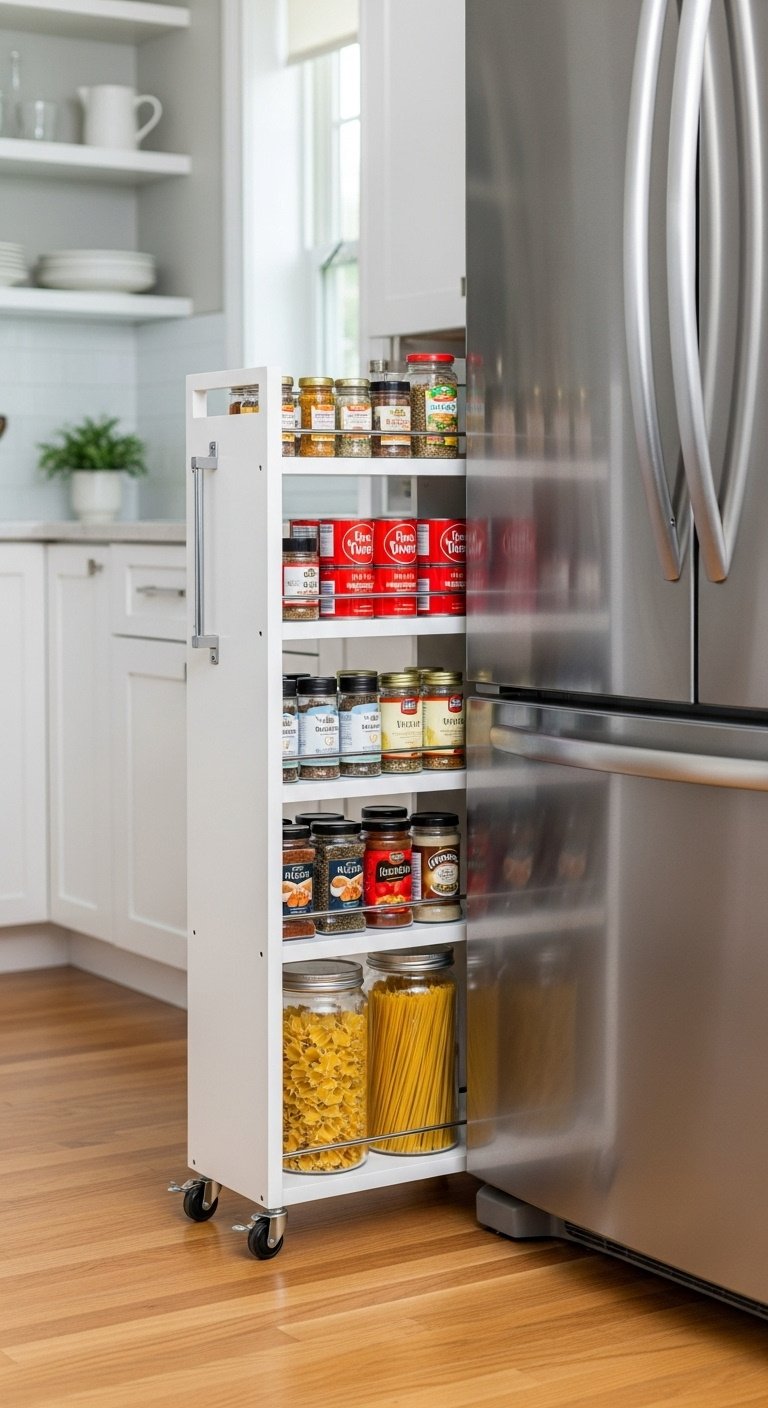
Turn wasted space into storage gold! Pin this DIY project now.
8. Open Up the Space with Floating Shelves
You can make your kitchen feel instantly more airy and open by strategically replacing some of your bulky upper cabinets with sleek floating shelves. This design choice reduces the visual weight in the room, preventing that heavy, “boxed-in” feeling that upper cabinets can create. It opens up sightlines and provides a beautiful, curated space to display your favorite dishes, glassware, or decorative items.
While it may seem like you’re sacrificing storage, this approach often leads to better organization. It forces you to be intentional about what you display, keeping your most-used items within easy reach while storing less-frequently used clutter elsewhere. The result is a kitchen that feels less like a storage unit and more like a stylish, lived-in space.
- Materials Needed: Floating shelf kit with hidden brackets, stud finder, drill, level, measuring tape.
- Step-by-Step Directions:
- Carefully remove one or two of your upper cabinets. You will need to patch and paint the wall behind them.
- Decide on the placement for your shelves. A common height is 18-24 inches above the countertop.
- Use a stud finder to locate the wall studs; this is crucial for supporting the weight of the shelves and dishes.
- Mount the hidden metal bracket securely into the wall studs using the provided screws. Use a level to ensure it’s perfectly straight.
- Slide the wooden shelf onto the bracket.
- Style the shelves with your most-used (and most attractive) dishes, glasses, and a few decorative items.
Lesson Learned: Be realistic about your tolerance for tidiness. Open shelves look best when kept neat and curated. If you have mismatched or chaotic items, it’s better to keep them behind a cabinet door.
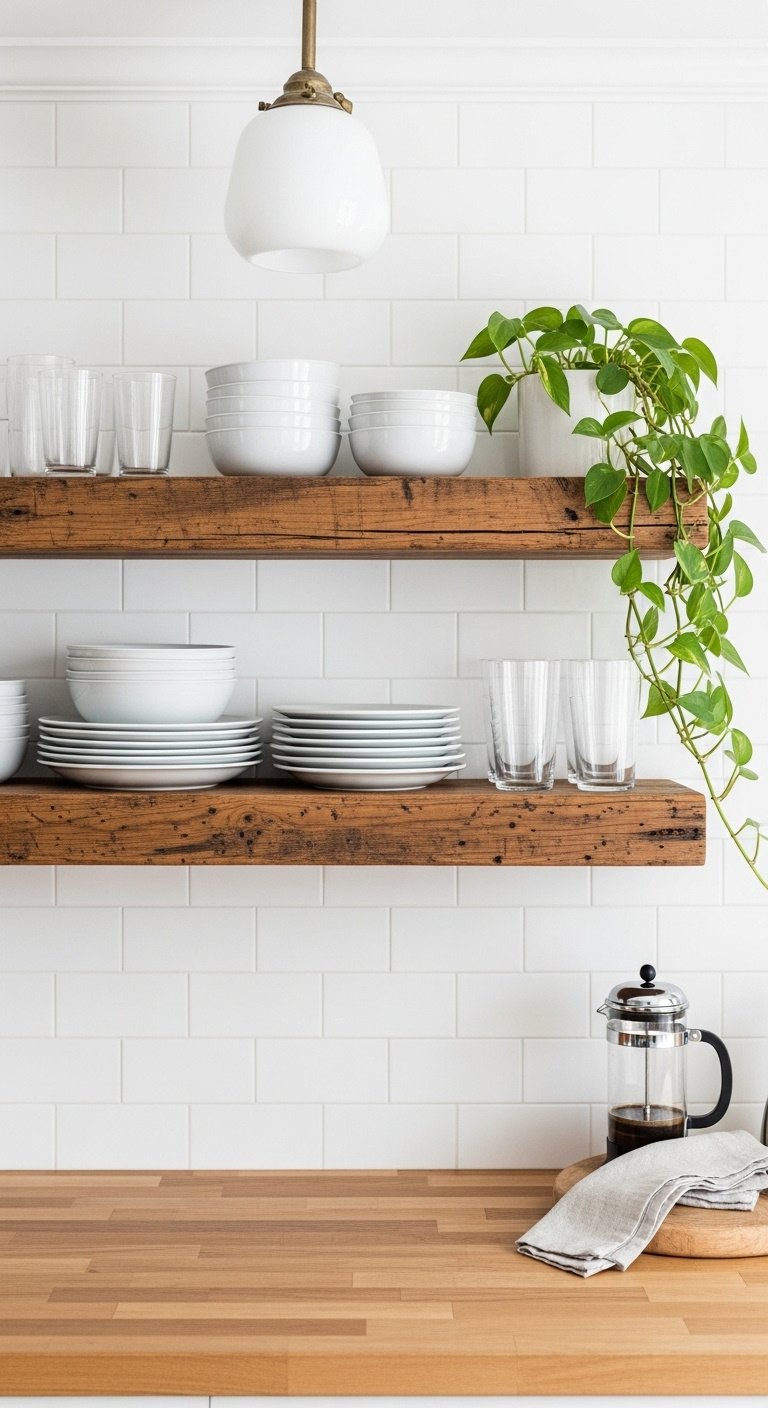
Want an airy, open kitchen? Pin this beautiful shelving idea!
9. Incorporate a Fold-Down Table for Dining and Prep
For kitchens that lack a dedicated dining area, a wall-mounted, fold-down table offers a brilliant, space-saving solution for both meals and extra prep space. When you need it, it provides a sturdy surface for two people to dine or for you to roll out dough. When you’re finished, it folds down flat against the wall, completely disappearing and reclaiming your valuable floor space.
This is the ultimate in multi-functional furniture for tight quarters. It eliminates the need for a bulky, permanent table that can obstruct walkways. Paired with a couple of slim, folding chairs that can be hung on wall hooks, this setup provides an on-demand dining nook that is both incredibly practical and perfectly suited for modern, minimalist living.
- Materials Needed: A pre-made wall-mounted drop-leaf table OR a solid piece of wood, heavy-duty locking shelf brackets, stud finder, drill, level, screws.
- Step-by-Step Directions:
- Identify an open section of wall in your kitchen where a small table would be useful.
- Use a stud finder to locate the wall studs. This is non-negotiable as the table needs strong support.
- Mark a level line on the wall at your desired table height (standard is 30 inches).
- Securely mount the folding brackets to the wall, making sure they are screwed directly into the studs.
- Attach your tabletop surface to the top of the brackets according to the manufacturer’s instructions.
- Test the folding mechanism to ensure it locks securely in both the up and down positions. Pair with slim folding chairs that can be hung on the wall.
Pro-Tip: When choosing a size for your tabletop, fold a piece of cardboard to the same dimensions and hold it up in the space. This will help you visualize how much room it will take up when open and ensure it doesn’t block any major walkways.
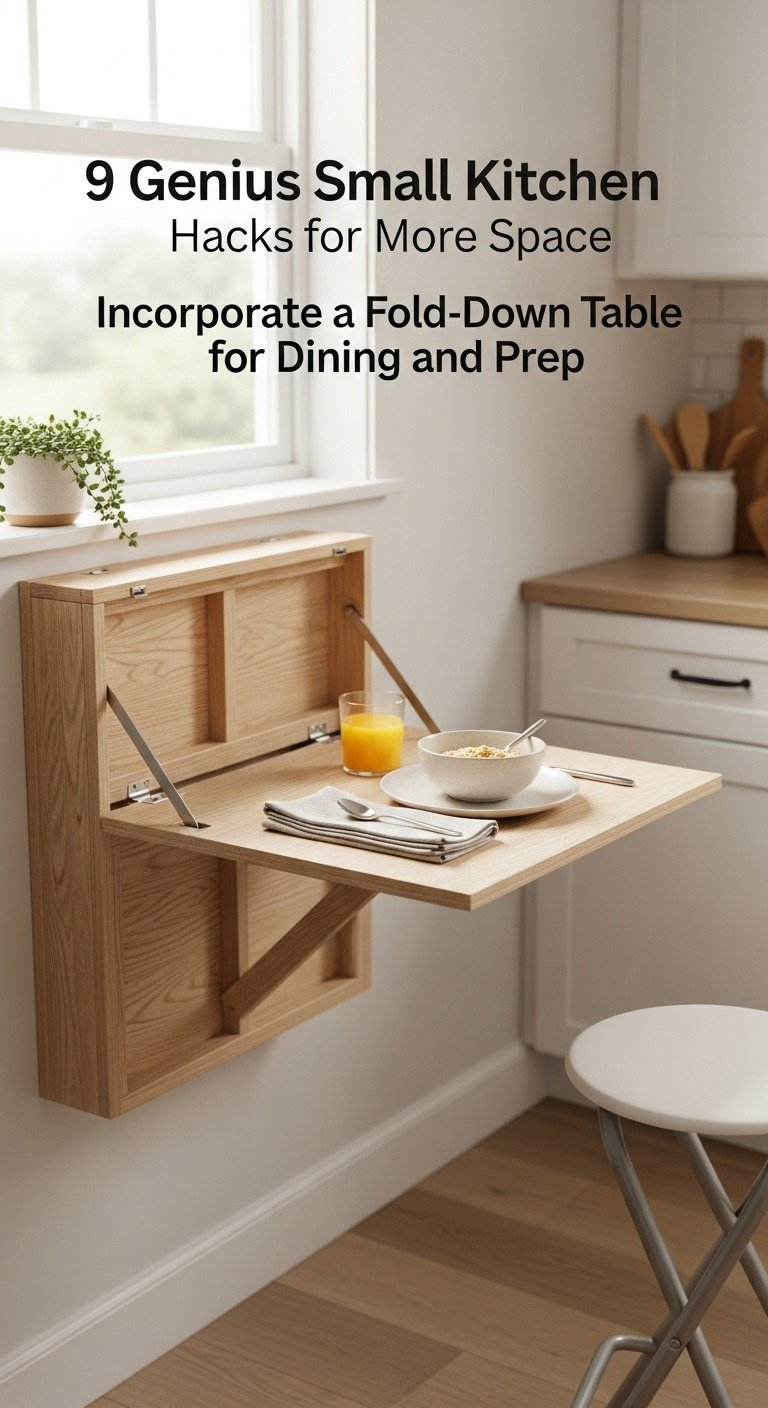
Save this multi-functional furniture idea for your small space!
Key Takeaways: Your Quick Guide to a More Spacious Small Kitchen
To successfully remodel a small kitchen, the core strategy is to be smarter, not necessarily bigger. By focusing on efficiency and visual perception, you can create a space that feels expansive and works beautifully. Here are the most important principles to remember:
- Think Vertically: Use walls for storage with shelves and racks to free up precious counter space.
- Find Hidden Spaces: Exploit unused areas like the space above cabinets, inside cabinet doors, and in toe-kicks.
- Choose Multi-Functional Pieces: Opt for mobile carts, over-the-sink accessories, and folding tables that serve multiple purposes.
- Create Visual Illusions: Use light colors, reflective surfaces, and smart lighting to make the room feel larger and brighter.
- Declutter Ruthlessly: A streamlined, minimalist approach is crucial. Less clutter makes any space feel bigger.
People Also Ask About Small Kitchen Remodels
How much should it cost to remodel a small kitchen?
The cost of a small kitchen remodel varies widely but typically ranges from $9,000 to $25,000 for a professional job. For a budget-friendly or DIY approach, costs can be significantly lower, often falling between $5,000 and $10,000 by focusing on cosmetic updates like painting cabinets, replacing countertops, and updating hardware.
Can you remodel a small kitchen for $5000?
Yes, you can absolutely remodel a small kitchen for $5,000 with smart planning. This budget typically covers cosmetic updates like painting existing cabinets, installing a new laminate or butcher block countertop, adding a new backsplash, updating lighting fixtures, and replacing hardware. It requires doing some labor yourself and choosing budget-friendly materials.
What is the first thing to do when remodeling a small kitchen?
The very first step is to define your goals and budget. Start by making a list of your biggest pain points with the current layout and functionality. Then, create a detailed plan and a firm budget. This initial planning phase is crucial for ensuring your remodel stays on track and meets your needs without unexpected costs.
Final Thoughts
A small kitchen isn’t a design flaw; it’s an opportunity for incredible creativity and efficiency. By implementing even one or two of these clever tipss, you can make a tangible difference in how your kitchen looks, feels, and functions. You don’t need a massive budget or a bigger floor plan to create a space that you truly love to cook and live in. It’s about making smart, high-impact choices that unlock the potential already within your walls.
Which of these space-saving tipss are you most excited to try in your kitchen? Let us know in the comments below
